Related Research Articles

The University of the Philippines is a state university system in the Philippines. It is the country's national university, as mandated by Republic Act No. 9500, giving it institutional autonomy.

The University of the Philippines Diliman, also referred to as UP Diliman or simply University of the Philippines (UP), is a public, coeducational, research university located in Diliman, Quezon City, Philippines. It was established on February 12, 1949, as the flagship campus and seat of administration of the University of the Philippines System, the premier and national university of the Philippines.

Quezon City, also known as the City of Quezon and Q.C., is the most populous city in the Philippines. According to the 2020 census, it has a population of 2,960,048 people. It was founded on October 12, 1939, and was named after Manuel L. Quezon, the second president of the Philippines.
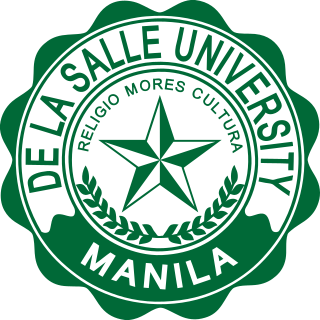
De La Salle University, also referred to as DLSU, De La Salle or La Salle, is a private, Catholic coeducational research university run by the Institute of the Brothers of the Christian Schools in Taft Avenue, Malate, Manila, Philippines. It was established by the Christian Brothers in 1911 as De La Salle College (DLSC) in Nozaleda Street, Paco, Manila with Blimond Pierre Eilenbecker, FSC serving as director, and is the first De La Salle school in the Philippines. The college was granted university status on February 19, 1975, and is the oldest constituent of De La Salle Philippines (DLSP), a network of 16 educational institutions, established in 2006 replacing the De La Salle University System.
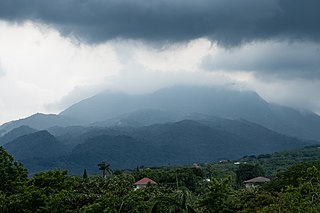
Los Baños, officially the Municipality of Los Baños, colloquialy 'elbi' or simply LB, is a 1st class municipality in the province of Laguna, Philippines. According to the 2020 census, it has a population of 115,353 people.

The University of Santo Tomas, officially the Pontifical and Royal University of Santo Tomas, Manila or colloquially as USTè, is a private, Catholic research university in Manila, Philippines. Founded on April 28, 1611, by Spanish friar Miguel de Benavides, third Archbishop of Manila, it has the oldest extant university charter in Asia and is one of the world's largest Catholic universities in terms of enrollment found on one campus. It is the main campus of the University of Santo Tomas System that is run by the Order of Preachers.

The University of the Philippines Manila is a public, coeducational, research university located in Ermita, Manila, Philippines. It is known for being the country's center of excellence in the health sciences, including health professional education, training, and research. It is the oldest of eight constituent universities of the University of the Philippines System, and predates the founding of UP by three years. It was originally established on December 1, 1905, as the Philippine Medical School and later renamed as the UP College of Medicine and Surgery on June 10, 1907. In 1983 it was renamed as University of the Philippines Manila.
Gregorio Fernandez Zaide was a Filipino historian, author and politician from the town of Pagsanjan, Laguna in the Philippines. A multi-awarded author, Zaide wrote 67 books and more than 500 articles about history, he is known as the "Dean of Filipino Historiographers." He was one of the founders of the International Association of Historians of Asia (IAHA), and president of the Philippine Historical Association for three terms. As a politician, he served as the mayor of his hometown of Pagsanjan from 1971 to 1975.

The National Library of the Philippines is the Philippines' official repository of information on cultural heritage and other literary resources. It is located in the district of Ermita in Manila, near historically significant offices and institutions such as the Museum of Philippine Political History and the National Historical Commission. As with these entities, it is under the jurisdiction of the National Commission for Culture and the Arts (NCCA).

Epifanio de los Santos y Cristóbal, also known as Don Pañong or Don Panyong, was a notable Filipino historian, journalist, and civil servant. He was regarded as one of the best Filipino writers and a literary genius. He also entered politics, serving as a member of the Malolos Congress from 1898 to 1899 from Nueva Ecija and later as governor of Nueva Ecija from 1902 to 1906. As a lawyer, he was named as the district attorney of San Isidro, Nueva Ecija in 1900 and later as fiscal of the provinces of Bulacan and Bataan. He was named as an assistant technical director of the Philippine Census in 1918. He was appointed Director of the Philippine Library and Museum by Governor General Leonard Wood in 1925, serving until his death in 1928.

Ambeth R. Ocampo is a Filipino public historian, academic, cultural administrator, journalist, author, and independent curator. He is best known for his definitive writings about Philippines' national hero José Rizal and on topics in Philippine history and Philippine art through Looking Back, his bi-weekly editorial page column in the Philippine Daily Inquirer.
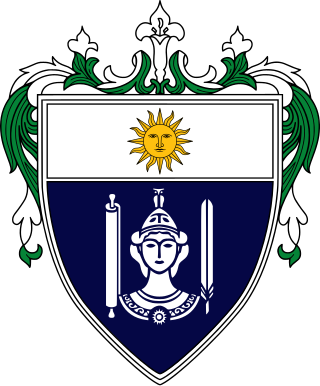
The University of Santo Tomas Faculty of Arts and Letters, popularly known as "UST Artlets" or "UST AB", is the liberal arts school of the University of Santo Tomas, the oldest and the largest Catholic university in Manila, Philippines.

Don Fabián de la Rosa y Cueto was a Filipino painter. He was the uncle and mentor to the Philippines' national artist in painting, Fernando Amorsolo, and to his brother Pablo. He is regarded as a "master of genre" in Philippine art.

The Central Philippine University Library is the library system of the Central Philippine University in Iloilo City, Philippines. Established in 1910, it is one of the largest academic and research libraries in the Philippines at present with more than 250,000 volumes or holdings it has, including special collections categorized into sections which include the 40,000+ United Nations Documents, American Studies Resource Center, Meyer-Asian Collection, Food and Agriculture Organization and Elizabeth Knox Sacred Music Collection. Rare collections of Second World War documents and Asian archaeological artifacts are also found in the collection of the main library.
Soledad Sarmiento Reyes is a Philippine literature scholar, literary and art critic, author, anthologist, consultant, professor, instructor, editor, annotator, researcher, and essayist in the Philippines. Specializing in the field of popular culture and the arts in the Philippines, Reyes is a professor teaching interdisciplinary studies at the University of the Philippines and the Ateneo de Manila University. She is an accomplished author of books and anthologies. "sa nobela mababalatuba ang mga pangyayati sa buhay ng isang kagawad sa union
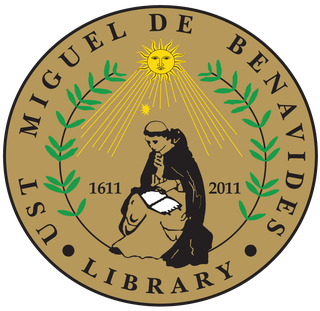
The Miguel de Benavides Library, also known as the University of Santo Tomas Library, is the main academic library of the University of Santo Tomas. The library has been in continuous service and its collection antedates the existence of the university itself.

The Archives of the University of Santo Tomas (AUST), also known in Spanish as the Archivo de la Universidad de Santo Tomas, is located at the Miguel de Benavides Library in Manila. The AUST is the central repository of historical and rare documents pertaining to, but not exclusively, to the history of the University of Santo Tomas, one of the oldest existing universities in Asia, and the oldest institution of higher learning in the Philippines. The collections consist of historical documents such as Papal bulls, royal decrees, rare Filipiniana prints, historical treatises, addresses, sermons, novenas, catechisms in many Philippine languages, national periodicals, and academic records of all educational institutions in the Philippines during the Spanish period. The archives is also home to the only incunabula, or books printed before 1500, in the country.
Carlos D. Arguelles was a Filipino architect who was known for being a leading proponent of the International Style of architecture in the Philippines in the 1960s. He was an Eagle Scout and a Distinguished Eagle Scout Awardee of the Boy Scouts of America.
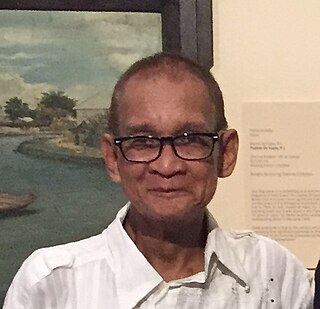
Santiago Albano Pilar more popularly known as Jak Pilar, was a Filipino art historian, curator, and author. He was best known for chronicling Philippine art centered on the 19th and the 20th century in numerous publications in both the Philippines and overseas.
References
- ↑ , Brief Statistical Profile, The University Library, University of the Philippines Diliman, www.mainlib.upd.edu.ph
- ↑ Philippines - Libraries and Museums, Encyclopedia of the Nations, www.nationsencyclopedia.com
![]() Media related to Libraries in the Philippines at Wikimedia Commons
Media related to Libraries in the Philippines at Wikimedia Commons